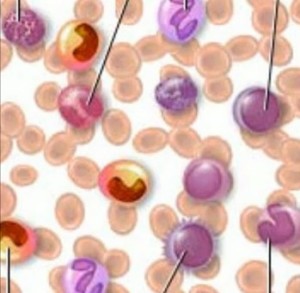Having a white blood cell count normal range is crucial in maintaining the body’s defense against detrimental, foreign invaders.
White blood cells (WBC) are formed elements found in the blood which protect the body against infection. White blood cells are also known as leukocytes. Since these cellsare the defense mechanism employed by the body to fight against and defend the body from harmful toxins, it is necessary to keep to the white blood cell count normal range.
A white blood cell lives for about 13 to 20 days in the blood, after which,the cell dies and is replaced by another leukocyte.This cycle is constant since the body requires a certain amount of white blood cells to effectively shield the body from harmful substances that invade the body.
The white blood cells come from the stem cells inside the red bone marrow. At first, a white blood cell takes the form of an immature cell called bands. These will eventually mature and becomeregular white blood cells. The production of the white blood cell depends on the needs of the body.
What are the components of white blood cells?
In blood test results, the white blood cell count normal range isusually expressed and subdivided into two subgroups, the granulocytes and agranulocytes.
Granulocytes
- Neutrophils – This is the most common component of the white blood cells. It is the first one to reach the site of infection wherein it will eat all the harmful substances.
- Basophils – These white blood cells release histamine and heparin to the site of infection which will cause the inflammation in the area and increase the flow of blood.
- Eosinophils –These are the type of white blood cells that fight off allergic reactions and parasitic infestations.
Agranulocytes
- Lymphocytes- The lymphocytes are further divided into two, the B cells and T cells.
The B cells are responsible for making the antibodies that help in fighting bacteria that attack the body. They also make the immunoglobulins M, A, D, G, E. Each of these performs different functions for the body’s immune system.
On the other hand, the T cells are responsible for attacking the viruses, bacteria or fungi that invade the body. It has killer or cytotoxic T cells, memory T cells, regulatory or suppressor T cells and helper T cells. These different types of T cells play varying roles in protecting the body.
- Monocytes –These protect the body against foreign substances. The monocytes will become phagocytes that will eat the harmful toxins that enter the body.

What are the tests employed to determine whether the quantity of WBC is beyond the white blood cell count normal range?
The Complete Blood Count (CBC) test is one of the most common laboratory examinations required of many patients either for screening or diagnosis. The complete blood count measures the amount of red blood cells, platelets and white blood cells. It would show whether the person is within the white blood cell count normal range or not. So, the CBC is the test that can detect any deviations from the white blood cell count normal range.
The white blood cell count normal range is between 5000 and 10,000 mm³. When the result is higher than the standard range, it is said that the patient has Leukocytosis. Leukocytosis is a condition typified by an elevation inthe white blood cell count indicating that there is an existing inflammation and infection in the body, which could have been brought about by stress or other factors. When the result is lower than white blood cell count normal range, the person is considered to have Leukopenia. Leukopenia occurs when the patient has an ongoing disease that requires medication that can lower the white blood cell count, such as steroids. Individuals with cancer and are undergoing cancer treatment do have reduced white blood cell count due to chemotherapy and radiation therapy.
What are the parameters measured in the Complete Blood Count?
When the health care provider gets the complete blood count, this would also include the specific components of white blood cells.The white blood cell count normal rangefor neutrophils is50 – 81%; Basophils should be between0 and 1%, Eosinophils range from1-5%, lymphocytes are within 14- 44%, and the monocytes from 2 to 6%. To be considered within the white blood cell count normal range, all the components of the white blood cells should not exceed the standard range. If one of the components deviates from the standard, the white blood cell count is said to be not normal.
Maintaining the white blood cell count normal range ensures that the body can react appropriately when an infection arises. Too high or too low white blood cell count does not guarantee the body of the protection it needs against harmful substances and microorganisms. The white blood cell count normal range should be sustained because harmful toxins can get into the body any time.
how does sertraline work for anxiety generic name for zoloft